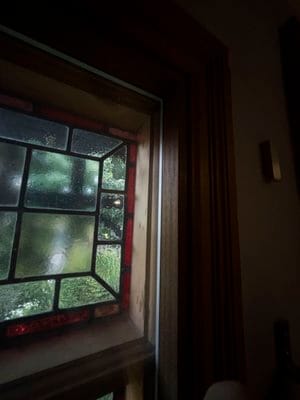- Welcome to Retrofitworks
- 0330 123 1334
- info@retrofitworks.co.uk


The gas bills were huge but the semi-detached house in Chorlton, Greater Manchester, was still freezing. The owners also wanted to get their carbon emissions as low as possible.
External wall insulation, internal wall insulation, refurbishment of windows and doors, floor insulation, room in roof insulation, loft insulation, solar heat panels, ground source heat pump.
The gable wall was the largest single heat loss surface in the building so this was externally insulated with woodfibre insulation with white render. The front and back ground floor rooms had original pressed-paper friezes and cornices which the owner wanted to keep, so a thin internal wall insulation system was used. Once the thick original plaster was taken off there was space for the insulation without changing the look of the rooms.
The house had the original set of single glazed windows, with stained glass features whose loss would have spoiled the look of the home.
The back of the house still had a full set of functioning Victorian sash windows. These were all very drafty.
The windows were treated in various ways:



The top floor rooms in the roof had the rafters extended to fit 200mm of insulation, stopping heat from escaping through the roof. The dormer windows were insulated with thin Aerogel insulation to avoid loss of space.
The floor was insulated from the cellar, by putting hemp insulation between the floor joists and replacing the plasterboard ceiling.
The heating and hot water is provided by a combination of solar thermal tubes on the roof and a ground source heat pump supplied from three bore holes drilled in the garden. Large hot water stores allow the heat pump to use cheaper electricity overnight, to keep the heating costs down. The heat pump creates around 3.5 times more heat than using standard electric heating.